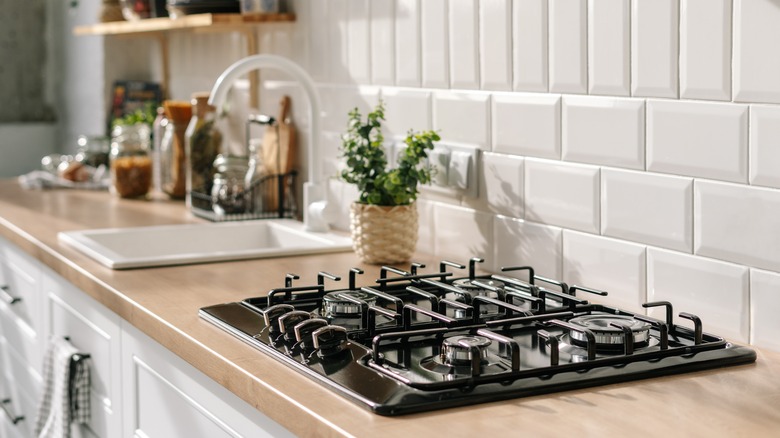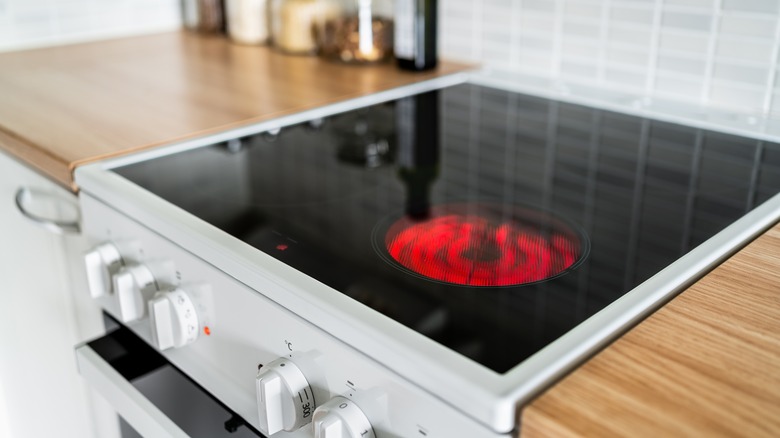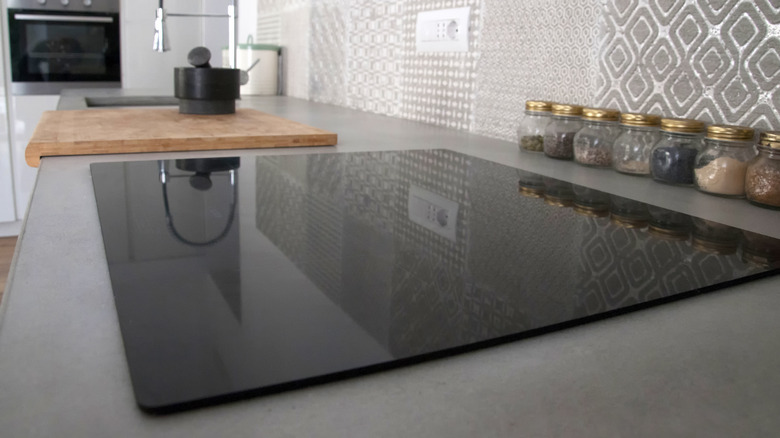Gas Or Electric? House Digest Survey Discovers Which Is The Most Popular Stovetop
House Digest surveyed its readers to find out which stovetop takes the gold. We polled 629 of our readers and asked what stovetop they'd want in their dream kitchen. Participants could choose between gas, electric, induction, down-draft, or commercial-style. While you may be familiar with a few of these types, having a primer on each choice is helpful.
Gas stoves have exposed burners and open flames, while electric stoves typically have a smooth range covering that conceals the heating coils, though some are exposed. Induction stovetops are similar to electric in that they use electricity and have a smooth hob. However, with one key difference — it only heats through a magnetic current when there is a metal cooking pan atop, says Frigidaire. Down-draft stovetops come in many forms, but their key feature is a built-in fan or ventilation system, removing the need for an overhead hood or fan. Finally, commercial-style stoves are typically gas ranges with all the bells and whistles: standard high-heat burners, grills, warming plates, and so on. Which of these stove types got the most props from readers? While answers varied, there was one clear winner.
Gas stoves take first place
Out of 629 votes, 290 (46.10%) opted for gas stoves in their dream kitchen. One of the key advantages of cooking with gas is that you can directly control the size of the flame, which offers better temperature control throughout the cooking process. Natural gas is also considerably cheaper to fuel stoves than electric, notes BlvdHome. And without the glossy glass stovetop, you don't have to worry about scratching your hob with cast iron or other heavy cookware.
However, despite readers' overwhelming preference for gas stoves, they have a significant con list going against them. In an exposé by Mother Jones, Rebecca Leber noted countless campaigns from the fossil fuel industry that encourage Americans to keep gas ranges, even though they pollute indoor air quality and contribute to a significant percentage of America's carbon emissions. Legislation around the country calls for new builds to include electric stoves and minimize the use of natural gas in residential and commercial spaces. That means electric stoves, which took 32.43% of the votes, may become increasingly popular in the coming years.
Why not electric?
Electric stoves pulled a hard-won second place in our poll, but gas still stretched ahead by a long shot. Per Consumer Reports, gas stoves don't provide better cooking abilities than electric ones. In a series of lab tests, they also found that large electric burners could heat up to higher temps significantly faster than gas stoves. There may be a few reasons outside of influence from fossil fuel lobbyists. Many folks like the way gas ranges look; the heavy grates and open blue flames are a classic, nostalgic aesthetic, while glass-covered electric ranges feel colder and more modern.
Further, glass can scratch, meaning you'll have to use heavy pans like cast iron and stainless steel more gingerly than you might on a gas range. However, if you want to use washing-up liquid and give the stovetop a quick scrub after cooking, the glass-covered electric range is a great choice, as you won't have to remove heavy grates or dig out the debris from a recessed range.
Induction may be on the come up
Induction cooktops came in third place in our survey, with 72 votes (11.45%). These stovetops boast similar consumer and environmental health benefits but only induct heat through a magnetic current. This means you need metal cookware on the burner to produce heat. One of the major downsides of this range is that it restricts the types of cookware you can use since aluminum and stainless steel won't create a magnetic current. However, many cookware manufacturers are now including a thin metal ring in these non-metal pots and pans to make them induction-compatible.
But this may require an expensive investment in buying new pots and pans. Many families opt for induction because it only heats the cookware on the burner. If you have children who climb on the counter, want to help out in the kitchen, or if you happen to be someone who forgets the burner is on, induction is an excellent choice because there won't be any still-hot burners to cause injuries. And, as Frigidaire notes, because the heat is directly transferred to the pot instead of the air around it, you won't notice the kitchen suddenly becoming swelteringly hot.
Down-draft and commercial-style stoves are typically either gas or stove range. Their bonus features, like the built-in ventilation for down-draft models (ideal for kitchen and stoves or open-floor plans,) aren't as important to consumers as the fuel source.



